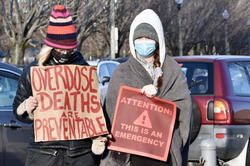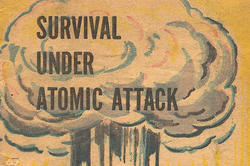RISD’s Center for Complexity uses the studio process of inquiry, iteration and innovation to envision novel solutions to the nationwide problem.
Opioid Crisis Spurs Compassionate Design

Last July Rhode Island legislators responded to the staggering number of statewide opioid overdoses by signing a bill that will allow the state to open independently operated harm reduction centers as part of a two-year pilot program. A similar program in New York City provides safe, supervised locations for people to use intravenous drugs and—in many cases—begin the long journey toward treatment and recovery.

Building on insights from two NIH-funded studios that RISD’s Center for Complexity (CfC) facilitated over the past year and working in collaboration with the Center for Biomedical Research Excellence on Opioids and Overdose based at Rhode Island Hospital, RISD students enrolled in a spring studio called Design Beyond Crisis imagined configurations of products, services, environments, systems and materials for the state’s pilot harm reduction centers. Their goal was to bring compassion into the complexities of managing these sites within a fractured and uneven system of care and to overcome the stigma that negatively impacts their design.
“The creation of new regulations and new modes of implementation must be rooted in creative ideas and considerations.”
“The creation of new regulations and new modes of implementation must be rooted in creative ideas and considerations,” says CfC Executive Director Justin W. Cook. “We have an opportunity here to do something that could dramatically reduce the harm inflicted by the approaches that came before.”

Senior Lead Tim Maly and recovery specialists Jon Soske led a daylong workshop in late April to shake loose untested ideas specifically tied to the entrances and exits of future harm reduction centers as well as notions of protection. “RISD students can ask surprising questions and come to insights that people working in the field can’t see because they’re too close to the problem,” Maly explains.
“RISD students can ask surprising questions and come to insights that people working in the field can’t see because they’re too close to the problem.”
As the spring semester came to a close, students presented their final proposals to a team of reviewers, including Soske, Rhode Island Senator Joshua Miller, RN Leigh Hubbard and fellow healthcare and recovery specialists Tyrone McKinney and Cassie Sutton Coats. Cook launched the session with a reminder for jurists to “critique what is and what could be. Ask yourselves what questions these projects raise and how the state might address them going forward,” he added.


Graduating senior Amy Qu 22 ID kicked things off with a series of drug testing strips that would allow users to know exactly what they were injecting and whether or not the deadly additive fentanyl was present. She proposes Safe and Sound bracelets incorporating test strips that would be distributed to everyone attending music festivals and other events where drug overdoses are common. The key element to her designs is user-friendly instructions written for non-scientists.
“Fentanyl test strips are one of the best tools we have in overdose prevention.”
“Fentanyl test strips are one of the best tools we have in overdose prevention,” Qu notes. “Until drug users gain access to a safe supply, these tests will allow them to make more informed choices. And distributing them to everyone would help to destigmatize them.”

Rising senior Yangchuan (Victor) Deng 23 IA also focused on destigmatizing services and tools designed for opioid users and envisioned a digital app similar to Yelp that would help people locate existing harm reduction centers in their neighborhoods and help government agencies determine where to build new ones. He was struck by the absence of apps addressing such a serious issue when he recently did an online search, in contrast to the dozens of apps available for niche hobbies like bird watching.
“This kind of information is crucial for saving lives.”
Called Safe Space, Deng’s app would also provide a centralized location for gathering and analyzing data related to the opioid epidemic, which is currently scattered. “This kind of information is crucial for saving lives,” he says. “And the system is very scalable and could become a nationwide resource.”

Grad student Meng Su MDes 23 used her expertise in interior architecture to conceive a highly speculative mobile harm reduction center raising questions about the tradeoffs between providing safety and privacy. And Yuting Sun MDes 23 focused on adaptive reuse, envisioning a new purpose for Providence’s Cathedral Square neighborhood, which is home to several churches. His design would incorporate a greenhouse, a co-working space and a café. “I see the chapel as a bridge linking the other buildings and also creating community so that users are not so isolated,” he explains.

A project by Mary Byrnes 22 IA makes use of a vacant CVS pharmacy in Providence’s Kennedy Plaza, a hotspot for drug use and overdose. Her design features mixed programming so users could enter and exit without being surveilled, and warm wood tones and organic shapes to promote comfort. “The architecture you’re suggesting supports the idea that drug users can be integrated into society,” Soske noted at the crit.
Shravan Rao MDes 23 also honed in on Kennedy Plaza, proposing public art that could begin there and radiate throughout the city, helping to destigmatize opioid use and educate the public. “The key question I’m asking is how a design intervention can be deployed to initiate dialogue,” he explains.
“The key question I’m asking is how a design intervention can be deployed to initiate dialogue.”
Now that the spring semester is over, the CfC team is working with sponsor Infosys on next steps for implementing the student designs. “A team of Infosys UX/UI designers are going to build the app that Victor proposed, and we’ll see where it goes from there,” says Cook. “Our hope is that other outcomes from the studio will also inform the work of the organizations here in Rhode Island doing this work. Opioid addiction is here for the long term, so we need to figure out as a society how we’re going to respond.”
—Simone Solondz / photos by Jo Sittenfeld MFA 08 PH
June 13, 2022


